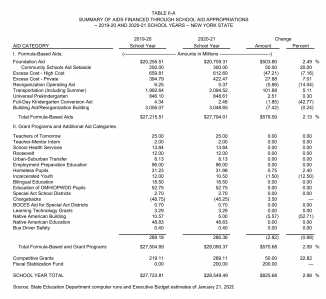The Executive Budget and Education
On January 21, 2020 Governor Cuomo presented his proposed state budget. SAANYS subsequently participated in several budget briefings and the following is a summary of the education portion of the proposed executive budget for 2020-21 based on SAANYS’ analysis and discussions.
The proposed state budget is being offered as a budget that “equalizes disparities, which directs funding to poorer schools and not just a district. In an attempt to decrease disparities, the proposed budget targets 85 percent of the Foundation Aid increase to highest need districts. In doing so the governor has proposed revising the formula to more evenly distribute funds. In the proposed budget this is accomplished with new tier formulas and reducing the current ten tiers to five.
Overall the 2020-21 proposed budget increases total aid to districts to $28.5 billion, which is a $826 million increase over last year. Of this increase $504 million is directed to Foundation Aid, however the increased aid is directed to the highest need districts.
Foundation Aid also includes a $50 million increase in community school funding; however, as a set aside carved out of foundation aid, it in effect decreases the actual foundation aid amount. The additional community school funding is anticipated to expand the total number of districts receiving funds to 440. The proposed budget establishes two tiers of funding for community schools. The Tier 1 is targeted to districts with a CSI school or a five-year growth in ELL students greater than the statewide average. Tier 2 districts are those that have not received community school funding in 2019-20.
Other substantial changes have been proposed in regard to expense-based aid. The proposed budget recommends that 10 categories be folded into Foundation Aid. Additionally, it creates a new tier for Building Aid for projects approved on or after July 1, 2020. SAANYS has asked for clarification as to whether approved means SED approval or public approval through budget votes. The stated intent is a desire to rein in the use of such funding for athletic fields or other “incidental costs.” For the school year 2021-22 a proposed cap on transportation expenses has been included as well.
Additionally:
- Charter schools will receive increased funding of about 5 percent. Nonpublic schools will realize a 3 percent increase in reimbursements.
- Funding has been included for new curriculum development in the areas of instruction in civic values, diversity, history, and religious freedom.
- Comprehensive Education and Workforce Training Center is anticipated to be developed in Syracuse. This would be a cooperative between the Syracuse CSD, BOCES, local institutes of higher education, and the community at large in the region. The state will reimburse up to 98 percent of the costs to renovate space required for the center.
- The Rochester CSD will have an SED appointed monitor to oversee finances and academic programs.
Other funding highlights:
• Increases for Universal Prekindergarten Aid – total of $848 million.
• Maintaining funding formulas used for “high cost excess costs,” private excess costs, and transportation aid.
• Decreased funding for full-day kindergarten conversion aid – total of $2.48 million.
• Decreased funding for Reorganization Incentive Operating aid – $5.37 million total.
• $13.84 million to maintain school health programs in the Big 4 City school districts.
• $18.5 million for Bilingual Education Grants, and
• A $50 million increase for the “support of performance grant program.”
The table below summarizes the proposed 2020-21 funding. CLICK ON TABLE TO ENLARGE
